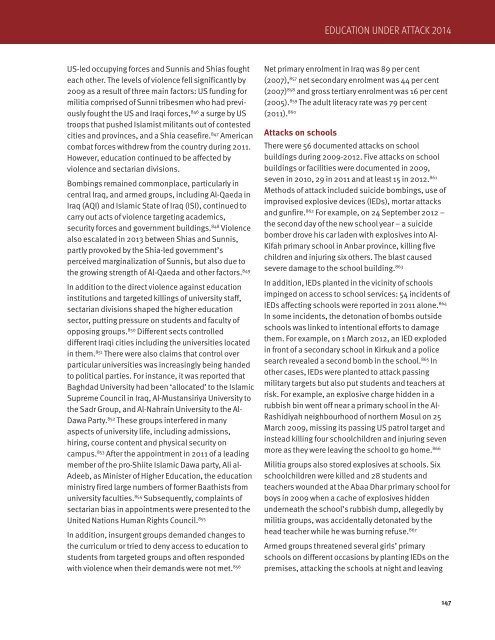eua_2014_full.pdf?utm_content=buffer4a392&utm_medium=social&utm_source=twitter
eua_2014_full.pdf?utm_content=buffer4a392&utm_medium=social&utm_source=twitter
eua_2014_full.pdf?utm_content=buffer4a392&utm_medium=social&utm_source=twitter
- No tags were found...
You also want an ePaper? Increase the reach of your titles
YUMPU automatically turns print PDFs into web optimized ePapers that Google loves.
EDUCATION UNDER ATTACK <strong>2014</strong>US-led occupying forces and Sunnis and Shias foughteach other. The levels of violence fell significantly by2009 as a result of three main factors: US funding formilitia comprised of Sunni tribesmen who had previouslyfought the US and Iraqi forces, 846 a surge by UStroops that pushed Islamist militants out of contestedcities and provinces, and a Shia ceasefire. 847 Americancombat forces withdrew from the country during 2011.However, education continued to be affected byviolence and sectarian divisions.Bombings remained commonplace, particularly incentral Iraq, and armed groups, including Al-Qaeda inIraq (AQI) and Islamic State of Iraq (ISI), continued tocarry out acts of violence targeting academics,security forces and government buildings. 848 Violencealso escalated in 2013 between Shias and Sunnis,partly provoked by the Shia-led government’sperceived marginalization of Sunnis, but also due tothe growing strength of Al-Qaeda and other factors. 849In addition to the direct violence against educationinstitutions and targeted killings of university staff,sectarian divisions shaped the higher educationsector, putting pressure on students and faculty ofopposing groups. 850 Different sects controlleddifferent Iraqi cities including the universities locatedin them. 851 There were also claims that control overparticular universities was increasingly being handedto political parties. For instance, it was reported thatBaghdad University had been ‘allocated’ to the IslamicSupreme Council in Iraq, Al-Mustansiriya University tothe Sadr Group, and Al-Nahrain University to the Al-Dawa Party. 852 These groups interfered in manyaspects of university life, including admissions,hiring, course content and physical security oncampus. 853 After the appointment in 2011 of a leadingmember of the pro-Shiite Islamic Dawa party, Ali al-Adeeb, as Minister of Higher Education, the educationministry fired large numbers of former Baathists fromuniversity faculties. 854 Subsequently, complaints ofsectarian bias in appointments were presented to theUnited Nations Human Rights Council. 855In addition, insurgent groups demanded changes tothe curriculum or tried to deny access to education tostudents from targeted groups and often respondedwith violence when their demands were not met. 856Net primary enrolment in Iraq was 89 per cent(2007), 857 net secondary enrolment was 44 per cent(2007) 858 and gross tertiary enrolment was 16 per cent(2005). 859 The adult literacy rate was 79 per cent(2011). 860Attacks on schoolsThere were 56 documented attacks on schoolbuildings during 2009-2012. Five attacks on schoolbuildings or facilities were documented in 2009,seven in 2010, 29 in 2011 and at least 15 in 2012. 861Methods of attack included suicide bombings, use ofimprovised explosive devices (IEDs), mortar attacksand gunfire. 862 For example, on 24 September 2012 –the second day of the new school year – a suicidebomber drove his car laden with explosives into Al-Kifah primary school in Anbar province, killing fivechildren and injuring six others. The blast causedsevere damage to the school building. 863In addition, IEDs planted in the vicinity of schoolsimpinged on access to school services: 54 incidents ofIEDs affecting schools were reported in 2011 alone. 864In some incidents, the detonation of bombs outsideschools was linked to intentional efforts to damagethem. For example, on 1 March 2012, an IED explodedin front of a secondary school in Kirkuk and a policesearch revealed a second bomb in the school. 865 Inother cases, IEDs were planted to attack passingmilitary targets but also put students and teachers atrisk. For example, an explosive charge hidden in arubbish bin went off near a primary school in the Al-Rashidiyah neighbourhood of northern Mosul on 25March 2009, missing its passing US patrol target andinstead killing four schoolchildren and injuring sevenmore as they were leaving the school to go home. 866Militia groups also stored explosives at schools. Sixschoolchildren were killed and 28 students andteachers wounded at the Abaa Dhar primary school forboys in 2009 when a cache of explosives hiddenunderneath the school’s rubbish dump, allegedly bymilitia groups, was accidentally detonated by thehead teacher while he was burning refuse. 867Armed groups threatened several girls’ primaryschools on different occasions by planting IEDs on thepremises, attacking the schools at night and leaving147


